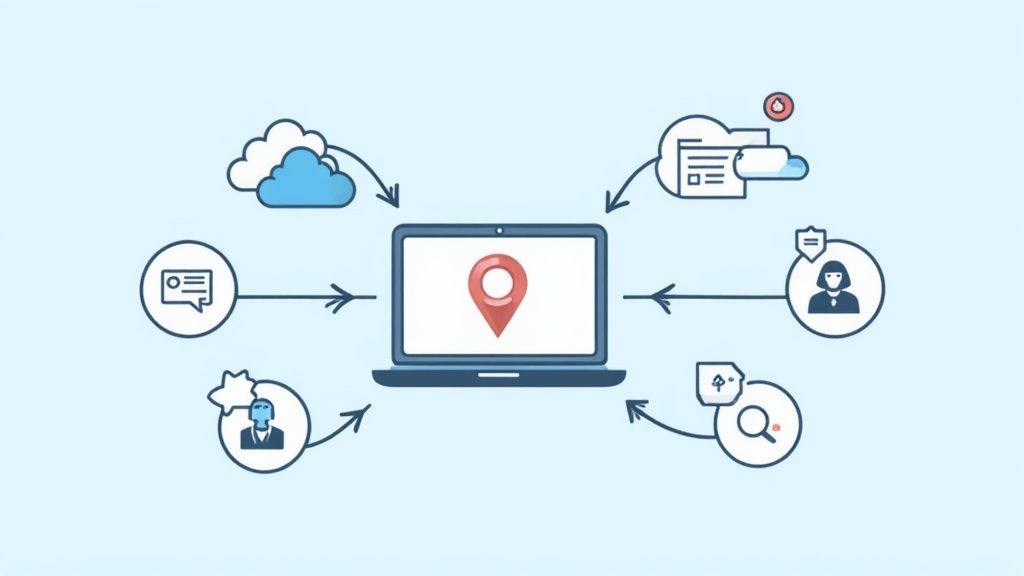
The shift to remote work is no longer a trend; it's a fundamental change in how high-performing teams operate. While many companies have adapted, true mastery lies beyond simply replicating office routines online. Effective remote leadership requires a deliberate, strategic approach to communication, culture, and performance management. This guide moves past the basics, offering a collection of actionable and refined remote team management tips designed to help you lead a distributed, productive, and genuinely engaged workforce.
We will explore proven strategies that build a foundation of trust, clarity, and connection, ensuring your team can excel regardless of physical location. These aren't just theories; they are practical steps you can implement immediately. For a comprehensive overview of strategies to help your remote team not just survive but thrive, explore this Ultimate Guide to Managing Remote Teams.
Whether you are scaling your tech startup with international developers or managing a creative agency's distributed talent, these insights will equip you to build a resilient and successful virtual organization. You'll learn how to refine your communication protocols, leverage technology for deeper collaboration, and foster a strong culture that transcends distance. Let's dive into the strategies that will unlock your team's full potential.
Effective remote team management begins with a solid communication foundation. Ambiguity is the enemy of productivity in a distributed environment, so establishing clear protocols is not just a suggestion; it's a necessity. This means creating a structured framework that dictates when, how, and where all team interactions occur, eliminating guesswork and ensuring everyone stays aligned.

This approach, popularized by all-remote pioneers like GitLab and Basecamp, moves beyond simply having tools and focuses on creating intentional communication habits. It’s about building a system that respects time zones, supports both synchronous and asynchronous work, and clarifies expectations for response times.
To make this one of the most effective remote team management tips you can implement, create a "Communication Charter" or a central document outlining your team's rules of engagement.
Here’s what to include:
Channel Definitions: Clearly define the purpose of each communication tool. For example:
Response Time Expectations: Set clear guidelines for how quickly team members are expected to respond on each channel. For instance, within 1-2 hours on Slack during work hours, but within 24 hours for email. This reduces anxiety and helps manage workloads.
Availability Indicators: Instruct your team to use status indicators in chat apps and block off focus time on shared calendars. This simple practice signals availability for collaboration without constant interruptions.
By formalizing these rules, you create a predictable and efficient communication environment that fosters trust and minimizes confusion, allowing your remote team to focus on high-impact work.
Beyond simply having access to software, one of the most crucial remote team management tips is to strategically select, integrate, and master the right technology stack. The goal is to create a digital ecosystem where work flows seamlessly from one platform to another, reducing friction and centralizing information. A poorly managed toolset can create more confusion than clarity, leading to information silos and wasted time.

Companies like Zapier and Shopify exemplify this by building integrated tech stacks that support every aspect of remote work. They don't just use tools; they create a unified digital headquarters. This means choosing platforms for video conferencing, project tracking, and file sharing that work in harmony, ensuring every team member is equipped and proficient.
Building a powerful and cohesive digital workspace requires a deliberate approach. The key is to move from a collection of individual apps to a truly integrated system that supports your team’s unique workflows.
Here’s how to get started:
Establish a Single Source of Truth: Designate one platform, typically your project management tool like Asana or Jira, as the definitive source for all project-related information. All tasks, updates, files, and decisions should live there, preventing vital details from getting lost in chat or email.
Provide Comprehensive Training: Never assume team members will figure out a new tool on their own. Provide structured onboarding, create best-practice documentation, and offer ongoing training sessions to ensure everyone uses the technology to its full potential.
Audit Your Tools Regularly: Conduct a quarterly audit of your tech stack to identify redundancies, underutilized software, and workflow gaps. Gather feedback from your team to understand what’s working and what isn’t, and be prepared to replace tools that no longer serve their purpose effectively.
By curating your technology intentionally, you empower your team with a reliable and efficient digital environment. For more guidance on choosing the right platforms, explore these must-have communication apps for remote teams.
In a remote setting, culture doesn't happen by accident; it must be built with intention. Fostering a strong team culture and connection is a critical remote team management tip because it counteracts the isolation that can undermine morale and collaboration. It's about intentionally creating shared experiences and reinforcing the values that bind your team together, even when separated by thousands of miles.

This approach, championed by culture-first leaders like Tony Hsieh of Zappos and Brian Chesky of Airbnb, recognizes that human connection is the bedrock of a high-performing team. When employees feel a sense of belonging and connection to their colleagues and the company's mission, they are more engaged, innovative, and loyal. To learn more about building this environment, see our guide on fostering a positive work culture with remote teams in LATAM.
Building culture from a distance requires a proactive strategy that creates dedicated spaces for informal, human interaction beyond project tasks and deadlines.
Here are some actionable ways to implement this:
Schedule Non-Work Interactions: Integrate virtual social events into your team's calendar. This could include:
Create Digital "Water Coolers": Designate specific channels in your chat tool (like Slack or Teams) for non-work conversations. Popular ideas include channels for #pets, #hobbies, #music, or #random. This replicates the spontaneous conversations that happen in an office.
Implement Recognition Programs: Actively celebrate individual and team achievements. Use a public channel to give shout-outs, implement peer-to-peer recognition tools like Bonusly, or highlight a "team member of the week" in a company-wide update.
By prioritizing these activities, you transform a group of remote individuals into a cohesive, connected, and supportive team. To further enhance this, consider how to improve team collaboration with AI by using smart tools that can facilitate connections and streamline shared workflows.
In a remote environment, managing by presence is impossible. Instead, effective leadership shifts to managing by results. This requires establishing transparent, measurable objectives and key performance indicators (KPIs) that connect individual contributions directly to team and organizational goals. This results-oriented approach values outcomes over hours logged, giving team members autonomy while ensuring everyone is pulling in the same direction.

This method, championed by management pioneers like Andy Grove at Intel and John Doerr with OKRs (Objectives and Key Results), provides the clarity and direction needed to thrive remotely. When expectations are clear and progress is visible, micromanagement becomes unnecessary. Instead, managers can focus on providing support and removing obstacles, fostering a culture of trust and high performance.
To make this one of the most impactful remote team management tips, move beyond annual reviews and build a dynamic goal-setting system. Frameworks like Google's OKRs or Salesforce's V2MOM (Vision, Values, Methods, Obstacles, Measures) are excellent starting points.
Here’s how to put it into practice:
Adopt a Goal-Setting Framework: Define clear objectives (what you want to achieve) and key results (how you'll measure success). For example, an objective might be "Improve Customer Onboarding," with key results like "Reduce average setup time by 20%" and "Increase user activation rate to 90%."
Involve Your Team in the Process: Foster ownership by having team members help set their own goals. This collaborative approach ensures objectives are realistic and increases buy-in, as individuals are more motivated to achieve targets they helped create.
Track Progress Transparently: Use shared dashboards in your project management tools or dedicated software to make goal progress visible to everyone. This transparency keeps the team aligned and creates a shared sense of accountability and momentum.
Provide Continuous Feedback: Don’t wait for quarterly reviews to discuss performance. Offer regular, constructive feedback and coaching. Celebrate the achievement of goals and, just as importantly, analyze and learn from initiatives that didn't hit their targets.
By defining what success looks like in measurable terms, you empower your team with the autonomy to deliver their best work, regardless of their location.
One of the most powerful remote team management tips is to move beyond the traditional 9-to-5 mindset and embrace flexibility. True remote work isn't just about changing location; it's about rethinking the structure of the workday itself. Offering adaptable schedules and arrangements allows team members to align their work with their peak productivity hours and personal lives, boosting morale and output.
This philosophy, championed by tech giants like Microsoft and Spotify, recognizes that autonomy is a key driver of engagement. When you trust your team to manage their own time while delivering on their responsibilities, you foster a culture of ownership and accountability. It's a strategic shift from monitoring hours worked to measuring results achieved.
Building a framework for flexibility ensures it enhances, rather than disrupts, team collaboration. It requires a balance between individual autonomy and team cohesion.
Here's how to structure it effectively:
Establish Core Collaboration Hours: Designate a specific window of 2-4 hours each day when all team members, regardless of their time zone, are expected to be online and available for synchronous communication. This protects collaborative time without enforcing a rigid full-day schedule.
Promote Calendar Transparency: Encourage everyone to use shared calendars to block out their working hours, focus time, and personal appointments. This practice makes it easy for colleagues to see availability at a glance, respecting individual schedules while simplifying meeting arrangements.
Develop Clear Handoff Processes: For asynchronous workflows, create standardized procedures for passing tasks between team members in different time zones. A clear handoff checklist in your project management tool can ensure nothing is lost in translation.
Set Expectations for Urgency: Define what constitutes an emergency and establish protocols for after-hours contact. This prevents burnout and ensures team members can truly disconnect, knowing they will only be contacted for genuinely critical issues.
By implementing these guidelines, you create a system that empowers employees with valuable flexibility while maintaining the structure needed for seamless team operations.
In a remote setting, spontaneous "water cooler" conversations and quick desk-side chats disappear. This makes structured, intentional communication essential for maintaining connection and alignment. Implementing a regular cadence of check-ins and feedback loops ensures that no team member feels isolated and that potential issues are addressed proactively before they escalate.
This approach, championed by management thinkers like Ben Horowitz and Kim Scott, creates a predictable rhythm for communication. It builds a system where feedback is a continuous, constructive part of the culture, not a dreaded annual event. For remote teams, these scheduled touchpoints are critical lifelines for support, mentorship, and course correction.
Creating a systematic approach to connection is one of the most powerful remote team management tips for fostering a supportive environment. The key is consistency and purpose.
Here’s a framework for getting started:
Structure Your 1:1 Meetings: Don't let one-on-ones become simple status updates. Use a shared agenda document where both manager and employee can add topics. Stripe is known for its highly structured weekly 1:1s, which use specific templates to guide discussions around challenges, career growth, and well-being.
Establish Team Rhythms: Supplement individual check-ins with regular team meetings. This could be a daily stand-up for quick updates or a weekly tactical meeting. Atlassian uses "Team Health Monitor" check-ins and retrospectives to assess and improve collaboration, communication, and team morale.
Build a Feedback Culture: Make feedback a normal part of your workflow. Encourage peer-to-peer recognition and use pulse surveys to gather anonymous input on team health. Ask open-ended questions like, "What’s one thing we could do to make your work more effective?" and always document and follow up on action items.
By embedding these practices into your team's routine, you create a resilient, connected, and continuously improving remote workforce.
Investing in your team's growth is a powerful retention strategy, especially in a remote setting where employees can feel disconnected from career advancement opportunities. Prioritizing professional development demonstrates a long-term commitment to your team members, boosting engagement, loyalty, and overall skill levels within your organization. This proactive approach prevents stagnation and ensures your team remains competitive and motivated.
This philosophy, championed by leaders like Satya Nadella at Microsoft with its "growth mindset" culture, treats learning not as a perk but as a core business function. In a remote context, this means creating intentional, structured pathways for growth that are visible and accessible to everyone, regardless of their location. Companies like Amazon and Shopify have institutionalized this with programs that directly fund employee education and skill development.
To make this one of the most impactful remote team management tips, you must move beyond simply offering a training budget. Build a comprehensive framework that integrates learning directly into the employee experience and career trajectory.
Here’s how to get started:
Create Individual Development Plans (IDPs): Work with each team member to create a personalized IDP that outlines their career aspirations, skill gaps, and clear goals. Review and update this plan quarterly or bi-annually to track progress and adjust priorities.
Offer Diverse Learning Opportunities: Provide a mix of resources to cater to different learning styles. This can include subscriptions to online course platforms, budgets for certifications, and dedicated time for self-paced learning, like LinkedIn's "InDay" concept. For insights into current trends, you can explore the evolving landscape of skill development in regions like LatAm.
Foster Internal Mentorship and Knowledge Sharing: Establish a formal mentorship program connecting junior employees with senior leaders. Encourage team members to host "lunch and learn" sessions or internal workshops to share their expertise, which reinforces learning and builds stronger team connections.
Link Learning to Real Projects: Ensure that newly acquired skills are applied to real-world tasks. This not only benefits the company by leveraging enhanced capabilities but also solidifies the employee's learning and demonstrates a clear return on the investment in their growth.
Micromanagement is the kryptonite of a thriving remote team. To truly unlock the potential of a distributed workforce, you must build a culture founded on trust and autonomy. This means empowering team members to own their responsibilities, make decisions, and manage their workflows without constant oversight, fostering a sense of accountability and professional growth.
This philosophy is championed by innovative companies like Netflix, with its famous "freedom and responsibility" culture, and Basecamp, which advocates for a "calm company" that prioritizes deep work over constant surveillance. The goal is to shift the focus from tracking activity to measuring results, which is a cornerstone of effective remote team management tips.
Building this culture requires intentional effort and clear boundaries. Your role as a manager transitions from a supervisor to a coach, providing support and removing obstacles rather than dictating every step.
Here’s how to put this into practice:
Define Scope and Boundaries: Clearly communicate the areas where team members have full autonomy and where they need to seek approval. This prevents confusion and empowers them to act confidently within defined guardrails.
Focus Check-ins on Support, Not Status: Frame your regular 1:1s and check-ins around questions like, "What support do you need?" or "Are there any roadblocks I can help clear?" rather than "What did you do today?" This reframes the interaction as supportive, not supervisory.
Start Small and Scale: Grant autonomy incrementally. Begin with smaller, low-risk decisions and gradually expand the scope as trust and confidence grow on both sides. This builds a foundation for greater responsibility over time.
Celebrate Autonomous Wins: Publicly recognize and celebrate instances where a team member took initiative, solved a problem independently, or made a great decision. This reinforces the desired behavior and shows the entire team that autonomy is valued.
By creating an environment of trust, you empower your team to perform at their best, leading to higher engagement, increased innovation, and superior outcomes.
| Strategy | Implementation Complexity | Resource Requirements | Expected Outcomes | Ideal Use Cases | Key Advantages |
|---|---|---|---|---|---|
| Establish Clear Communication Protocols | Medium (setup and ongoing updates) | Moderate (time for documentation and training) | Reduced miscommunication, improved coordination | Distributed teams needing aligned communication | Clear expectations, accountability |
| Leverage Technology and Collaboration Tools Effectively | High (tool selection and training) | High (subscriptions, training efforts) | Centralized work, real-time collaboration | Teams needing integrated digital workflows | Transparency, automation, searchability |
| Foster Team Culture and Connection | Medium to High (time and commitment) | Moderate (activities and programs) | Increased engagement and retention | Remote teams prone to isolation | Stronger trust and culture alignment |
| Set Clear Goals and Performance Metrics | Medium to High (planning and communication) | Moderate (dashboard tools, review cycles) | Clear direction, increased accountability | Outcome-focused teams | Objective evaluations, strategy alignment |
| Provide Flexible Work Arrangements | Medium (policies and coordination) | Moderate (stipends, scheduling tools) | Enhanced work-life balance, productivity | Global teams with diverse needs | Talent attraction, reduced stress |
| Implement Regular Check-ins and Feedback Loops | Medium (meeting rhythms and training) | Moderate (manager time investment) | Strong relationships, proactive issue resolution | Teams needing continuous alignment | Accountability, communication improvement |
| Support Professional Development and Career Growth | Medium to High (program creation and tracking) | High (budgets, training resources) | Increased engagement and skills development | Growing teams focused on retention | Employee growth, capability enhancement |
| Establish Trust and Autonomy | Medium (culture change and guidelines) | Low to Moderate (training and communication) | Higher motivation, productivity, and innovation | Self-motivated remote teams | Reduced micromanagement, resilient teams |
Navigating the landscape of remote work requires more than just adapting; it demands a strategic, intentional approach to leadership. The remote team management tips we've explored throughout this guide are not isolated tactics but interconnected pillars of a robust operational framework. From establishing crystal-clear communication protocols and leveraging the right technology to fostering a genuine team culture and setting unambiguous performance metrics, each strategy works in concert to build a resilient, high-performing distributed team.
The common thread woven through these principles is the cultivation of trust. When you grant your team autonomy, support their professional growth, and implement consistent, constructive feedback loops, you create an environment where top talent can truly excel. This intentionality transforms remote management from a challenge to be overcome into a powerful competitive advantage, unlocking productivity and innovation that transcends geographical boundaries.
Mastering these concepts is the key to unlocking the full potential of your distributed workforce. But effective management is only one half of the equation; the other is sourcing world-class talent ready to thrive in such an environment. Your immediate next step is to bridge the gap between your management strategy and your talent acquisition pipeline.
Begin by evaluating your current practices against the tips provided.
An honest assessment will reveal critical areas for improvement. For an even more comprehensive approach to leading your distributed workforce, consider exploring an ultimate guide on how to manage remote teams to deepen your understanding of these advanced concepts.
Ultimately, the most sophisticated remote team management tips are only as effective as the people on your team. Building a world-class remote organization starts with hiring professionals who are not only skilled in their craft but also possess the discipline, communication skills, and proactive mindset required for remote success.
This is where a strategic hiring partner becomes indispensable. LatHire specializes in connecting innovative companies with the top 1% of pre-vetted tech and creative talent from Latin America. Our AI-powered platform streamlines the process, matching you with candidates who fit your technical requirements, time zone, and company culture. More importantly, we handle the complexities of international payroll, benefits, and compliance, freeing you to focus on what you do best: leading your team and scaling your business.
By merging these elite management practices with a superior talent pipeline, you don't just build a remote team; you construct a global powerhouse. You create a workforce that is engaged, productive, and perfectly positioned to drive your organization's success in the modern digital era. The future of work is remote, and with the right strategy and the right people, that future is yours to lead.
